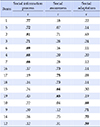1. Saxena S, Jain RK. Social intelligence of undergraduate students in relation to their gender and subject stream. International Journal of Research & Method in Education. 2013; 1(1):1–4.

2. Goleman D, Boyatzis R. Social intelligence and the biology of leadership. Harvard Business Review. 2008; 86(9):74–81.
3. Nehrir B, Vanaki Z, Mokhtari JN, Khademolhosseini SM, Ebadi A. Competency in nursing students: a systematic review. International Journal of Travel Medicine and Global Health. 2016; 4(1):3–11. DOI:
10.20286/IJTMGH-04013.

4. Weis S, Süß HM. Reviving the search for social intelligence-a multitrait-multimethod study of its structure and construct validity. Personality and Individual Differences. 2007; 42(1):3–14. DOI:
10.1016/j.paid.2006.04.027.

5. Anwer M, Malik NI, Maqsood A, Rehman G. The moderating role of social intelligence in explaining attachment style and emotional intelligence among young adults. Pakistan Journal of Psychology. 2017; 48(2):3–20.
6. Başoğul C, Özgür G. Role of emotional intelligence in conflict management strategies of nurses. Asian Nursing Research. 2016; 10(3):228–233. DOI:
10.1016/j.anr.2016.07.002.

7. Frankovsky M, Birknerová Z. Measuring social intelligence-the MESI methodology. Asian Social Science. 2014; 10(6):90–97. DOI:
10.5539/ass.v10n6p90.

8. Habib S, Saleem S, Mahmood Z. Development and validation of Social Intelligence Scale for university students. Pakistan Journal of Psychological Research. 2013; 28(1):65–83.
9. Lee HY, Oh KS, Ahn YH, Lee SJ, Kim IJ. Exploratory study on scales of nursing education outcome. Journal of East-West Nursing Research. 2010; 16(1):53–60.
10. Park SW. The validity and reliability testing of the Tromsø-Social Intelligence Scale in Korean college students. Journal of Korean Academy of Psychiatric and Mental Health Nursing. 2007; 16(2):190–197.
11. Silvera D, Martinussen M, Dahl TI. The Tromsø Social Intelligence Scale, a self-report measure of social intelligence. Scandinavian Journal of Psychology. 2001; 42(4):313–319. DOI:
10.1111/1467-9450.00242.

12. Doğan T, Çetin B. The validity, reliability and factorial structure of the Turkish version of the Tromso Social Intelligence Scale. Educational Sciences: Theory & Practice. 2009; 9(2):709–720.
13. Gini G. Brief report: adaptation of the Italian version of the Tromsø Social Intelligence Scale to the adolescent population. Journal of Adolescence. 2006; 29(2):307–312. DOI:
10.1016/j.adolescence.2005.05.003.

14. Grieve R, Mahar D. Can social intelligence be measured? Psychometric properties of the Tromso Social Intelligence Scale-English version. The Irish Journal of Psychology. 2013; 34(1):1–12. DOI:
10.1080/03033910.2012.737758.

15. Björkqvist K, Österman K, Kaukiainen A. Social intelligence - empathy=aggression? Aggression and Violent Behavior. 2000; 5(2):191–200. DOI:
10.1016/S1359-1789(98)00029-9.
16. Darban F, Karamzehi R, Balouchi A, Safarzai E, Salehian T, Hoseynzehi M, et al. The relationship between social intelligence and death anxiety among elderly people living in Iranshahr, Iran. International Journal of Mental Health and Addiction. 2016; 14(6):896–900.

17. Won SJ, Heo CU, Choi YS. The effects of school life, emotional intelligence, and social intelligence on resilience of nursing university students. Biomedical Research. 2018; 29(21):3829–3834. DOI:
10.4066/biomedicalresearch.29-18-1049.

18. Terwee CB, Mokkink LB, Knol DL, Ostelo RWJG, Bouter LM, de Vet HC. Rating the methodological quality in systematic reviews of studies on measurement properties: a scoring system for the COSMIN checklist. Quality of Life Research. 2012; 21(4):651–657. DOI:
10.1007/s11136-011-9960-1.

19. Munro BH. Statistical methods for health care research. 5th ed. Philadelphia PA: Lippincott Williams & Wilkins;2005. p. 494.
20. Hur GH. Construction and validation of a Global Interpersonal Communication Competence Scale. Korean Journal of Journalism & Communication Studies. 2003; 47(6):380–408.
21. Rubin RB, Matin MM, Bruning SS, Power DE. Interpersonal communication competence: scale development and test of a self-efficacy model. Paper presented at: The annual conference of the speech communication association. Atlanta, GA: 1991.
22. Rafiey H, Soleimani F, Torkzahrani S, Salavati M, Nasiri M. Scale development and psychometrics for parents' satisfaction with developmental care in neonatal intensive care unit. Iranian Journal of Child Neurology. 2016; 10(4):16–24.
23. Fayers PM, Machin D. Quality of life: the assessment, analysis and reporting of patient-reported outcomes. 3rd ed. Chichester, UK: John Wiley & Sons;2016. p. 648.
24. Back CY, Hyun DS, Chang SJ. Association between emotional labor, emotional dissonance, burnout and turnover intention in clinical nurses: a multiple-group path analysis across job satisfaction. Journal of Korean Academy of Nursing. 2017; 47(6):770–780. DOI:
10.4040/jkan.2017.47.6.770.

25. Ware JE, Gandek B. Methods for testing data quality, scaling assumptions, and reliability: the IQOLA project approach. international quality of life assessment. Journal of Clinical Epidemiology. 1998; 51(11):945–952.
26. Willmann E, Feldt K, Amelang M. Prototypical behaviour patterns of social intelligence: an intercultural comparison between Chinese and German subjects. International Journal of Psychology. 1997; 32(5):329–346. DOI:
10.1080/002075997400692.

27. Markopoulos P. Awareness systems and the role of social intelligence. AI & Society. 2009; 24(1):115–122. DOI:
10.1007/s00146-009-0194-5.

28. Goleman D. Working with emotional intelligence. New York: Bantam Books;2006. p. 358.







 PDF
PDF ePub
ePub Citation
Citation Print
Print





 XML Download
XML Download